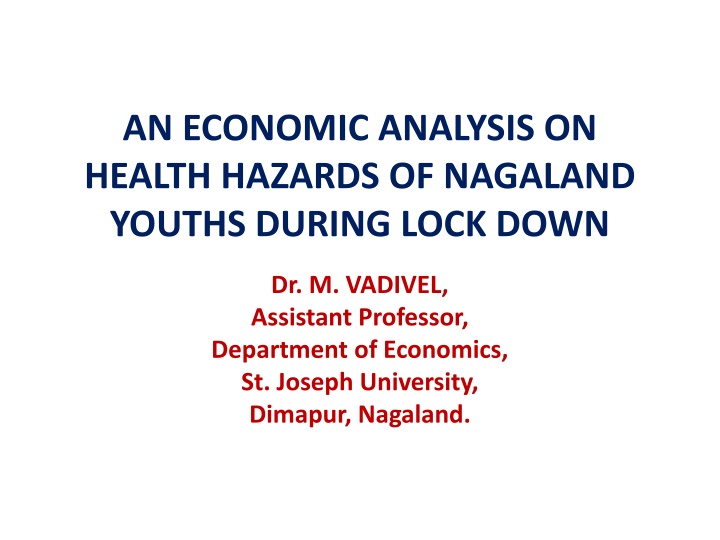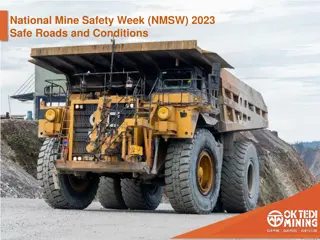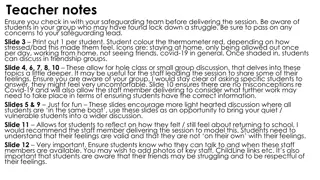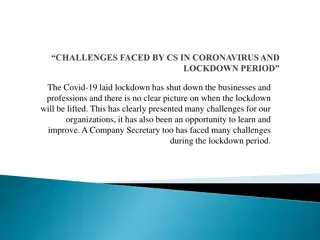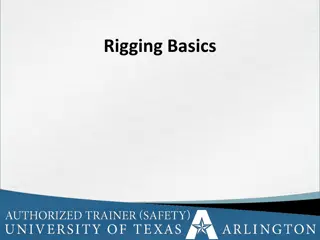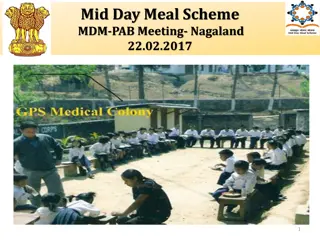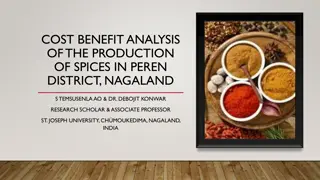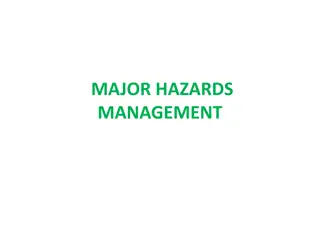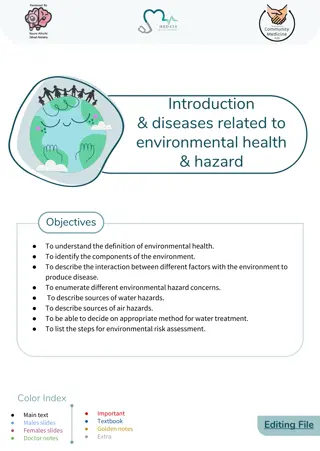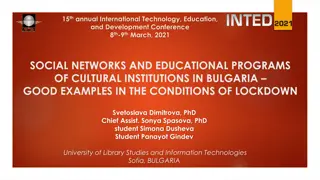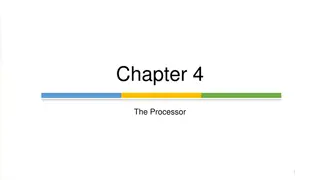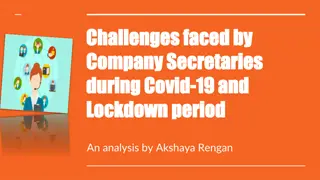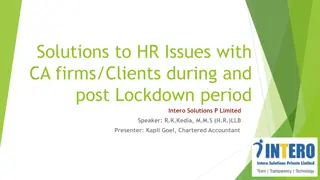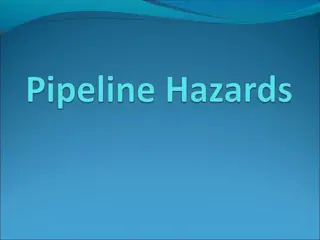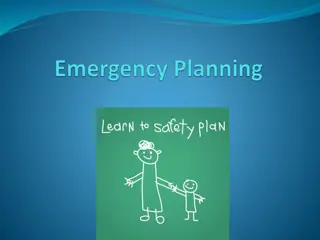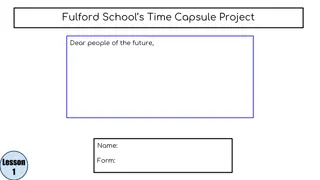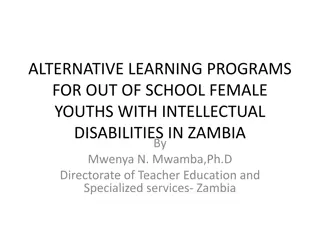Economic Analysis of Health Hazards Faced by Nagaland Youths During Lockdown
Analyzing the health hazards faced by Nagaland youths during the lockdown, focusing on tobacco use, alcohol consumption, and the widespread use of harmful substances like Pan Masala. The study highlights the economic impact and risks associated with these behaviors.
Download Presentation

Please find below an Image/Link to download the presentation.
The content on the website is provided AS IS for your information and personal use only. It may not be sold, licensed, or shared on other websites without obtaining consent from the author.If you encounter any issues during the download, it is possible that the publisher has removed the file from their server.
You are allowed to download the files provided on this website for personal or commercial use, subject to the condition that they are used lawfully. All files are the property of their respective owners.
The content on the website is provided AS IS for your information and personal use only. It may not be sold, licensed, or shared on other websites without obtaining consent from the author.
E N D
Presentation Transcript
AN ECONOMIC ANALYSIS ON HEALTH HAZARDS OF NAGALAND YOUTHS DURING LOCK DOWN Dr. M. VADIVEL, Assistant Professor, Department of Economics, St. Joseph University, Dimapur, Nagaland.
Introduction Tobacco use is a major risk factor for many chronic diseases, including cancer, lung disease, cardiovascular disease and stroke. Tobacco kills more than 8 million people each year half of its users. More than 7 million of those deaths are the result of direct tobacco use while around 1.2 million are the result of non- smokers being exposed to second-hand smoke. Over 80% of the world's 1.3 billion tobacco users live in low- and middle-income countries. It is one of the major causes of death and disease in India and accounts for nearly 1.35 million deaths every year. India is also the second largest consumer and producer of tobacco.
Alcohol Consumption Alcohol per capita consumption increased in the WHO Western Pacific and South-East Asia regions. Highly populated country India account for the increases, year wise 2.4 litres, 4.3 litres & 5.7 litres in 2005, 2010 and 2016 respectively. 15-19 Age category of youths were mostly drinking in total population. Globally, 44.8% of total recorded alcohol is consumed in the form of spirits, which is also the most consumed beverage type in the South-East Asia Region (87.9%), Eastern Mediterranean Region (48.3%) and Western Pacific Region (58.8%). The second most consumed beverage type is beer, which accounts for 34.3% of all recorded alcohol consumed in the world.
HEALTH HAZARDS Like tobacco products, Pan Masala is widely used across all the strata of society and is freely available in many parts of the country. It is carcinogenic, genotoxic, and has harmful effects on the oral cavity, liver, kidneys and reproductive organs. Pan Masal showed presence of testicular cysts, increased structural abnormalities in sperms and decreased weight of testis. The ovaries and kidneys were also affected showing inflammatory reaction and cysts. There was acute increase in pulse rate, systolic and diastolic blood pressure on consumption of Pan Masala (Sharma AK, et al., 2000). Every gram of PM consumed leads to exposure of about 1.2 2 mg aluminum and 23.5 185 g fluorine leading to adverse effects due to toxic accumulation. Liquor refers to whisky, rum, vodka, gin and brandy with ethanol content of 42.8% by volume were producing. It injurious health.
REVIEW OF THE STUDY Alcohol-related problems account for over a fifth of hospital admissions (Sri et al., 1997, Benegal et al., 2001) but are under recognized by primary care physicians. Alcohol misuse has been implicated in over 20% of traumatic brain injuries (Gururaj, 2002), and 60% of all injuries reporting to emergency rooms (Benegal et al., 2002). Alcohol misuse wreaks a high social cost (Bhatt, 1998; Rao et al., 2001). monetizable direct and indirect costs attributable to alcohol, counting only persons with alcohol dependence, were more than 3 times the profits from alcohol taxation (Benegal et al., 2000). Previous studies, from all over India, have similarly observed that one out of two people who drink alcohol do so at hazardous levels. Suu highlighted (2021) pointed out the tobacco scenario among school and colleges in Dimapur District with participants between the age group of 15-24 years, 10% of the students smoked tobacco products, while 10.8% consumed Paan and 26% chew tobacco.
Continues Peer pressure (76%) was the most common reason for initiation. Pocket money (57.1%) was found to be the major source of purchasing for tobacco use and promotional advertisement (Shrivastava et al., 2015). Mukherjee et al., (2012) said the significant association between knowledge and practice and the age of initiation (11 16 years of age) implies that education about hazards of tobacco use. Worldwide tobacco consumption, alcohol and associated habits are considered major causes of morbidity and mortality (Amit Das & Gayatree Roy, 2016). Pallavi Sinha 2017), discovered the role of prior history of TB infection is alcohol and smoking in increasing the risk of developing TB and MDR-TB. Saxena S, Sharma R, Maulik PK (2003). Families had at least one adult consuming alcoholic drinks at least 3 times per week in the last month and some families had no adult consuming more than one drink in the last month.
PRODUCTS OF TABACCO Forms of tobacco intake comprises of Cigarette Most common and most harmful, Bidi most commonly used form in India, Cigar -Hookah (Hubble bubble), Sheesha, Tobacco chewing, Kreteks (clove cigarettes), Snuff Moist & Dry, E-cigarette recent intruder in the list. When non-smokers are exposed to smoke containing nicotine and toxic chemicals emitted by smokers it is called passive smoking or exposure to second hand smoke.
REASONS FOR DRINKING Among drinkers, had significantly higher scores than on drinking for tension relief, but not for enhancement of positive expectancies. This translates into a lower annual consumption in women. Drinking five to six drinks in about half an hour can lead to very high Blood Alcohol levels, which in turn is likely to predispose to greater morbidity. The youths however, appeared to prefer sipping drink rather than gulping it down, in a departure from the overall trend. In general, women were less likely to display patterns of hazardous drinking.
SYMPTOMS Most of the Tobacco users had characteristics features of substance abuse comprising tolerance That developed in 2 3 months, craving and substance seeking behavior. Within 2 3 hours of abstinence, the subjects developed withdrawal symptoms comprised anxiety, restlessness, tremors, loss of appetite, lacrimation, giddiness, breathlessness, vomiting and intense craving. body pains, insomnia, Few withdrawal symptoms mimicked opiate withdrawal. Three successfully treated using benzodiazepines. out of four patients with addiction were
HEALTH HAZARDS OF TOBACCO, SMOKING AND LIQUOR CONSUMPTION Smoking causes cancer, heart disease, stroke, lung diseases, diabetes, and pulmonary disease (COPD), emphysema and chronic bronchitis. Smoking also increases risk for tuberculosis, certain eye diseases, and problems of the immune system, including rheumatoid arthritis. Alcohol consumption also injurious to health which leads to some diseases namely Heart Attack, Cardio related diseased, Depression, Mental Disorder related diseases and Brain prone diseases. chronic obstructive includes which
PROFILE OF THE STUDY Nagaland is the second-highest consumer of tobacco in the Northeast with a prevalence rate at 57% smokers, Cigarette accounts for 26.3% followed by other gutkha products. 28.3% of school-going children are smokeless tobacco users, while 14.8% are into smoking habits and 41.2% children engaged by parents to buy tobacco [Nagaland School Oral Health Survey 2014 report]. In Nagaland, tobacco users between the age group of 15-24 year is 28.6% which is an alarming rate and a great concern. Tobacco consumption pattern among youths in Nagaland is similar to adult consumptions and is much higher than consumption by India youths (12.4%). In Nagaland state school students were taking tobacco products and smoking and finally they addicted to alcohol much more liquors they consume in institution and around campus.
RESEARCH METHODOLOGY Aim: The aim of this initial study was to assess the impact of Using Tobacco products, Smoking habits and heavy drinking of youths and health hazards in Nagaland, India.
SCOPE OF THE STUDY Tobacco is a major risk factor for a number of diseases affecting all age groups. Most of the tobacco from Northern India and Afghanistan comes from the species Nicotiana rustica. This huge burden of NCDs can be attributed to increasing use of tobacco. Around five million of those deaths are the result of direct tobacco use while more than 600,000 are the result of non-smokers being exposed to second-hand smoke. One person dies every six seconds due to tobacco. Up to half of current users will eventually die of a tobacco-related disease. The situation is equally bad in India with estimated number of tobacco users being 274.9 million where 163.7 million users of only smokeless tobacco, 68.9 million only smokers and 42.3 million users of both smoking and smokeless tobacco as per Global Adult Tobacco Survey India (GATS). It means around 35% of adults (47.9% males and 20.3% females) in India use tobacco in some form or the other. Use of smokeless tobacco is more prevalent in India (21%).
OBJECTIVES OF THE STUDY To investigate whether life style and food habits of Nagamese youths is changed or nor during covid-19 lockdown. To assess the perceptions of Naga people regarding tobacco products consumption in their life. and alcohol To investigate health hazards of youths after the consumption of (tobacco products) and use of alcohol. prohibited products
MATERIAL AND METHODS The study was conducted using a Descriptive Survey Method. Primary data were collected from Nagaland people particularly youths from Dimapur District. (N=100). The sample for the study consisted of No availability of suitable Data, only random sampling carried out. For all, 120 were surveyed and only 100 youths took for study who were additive for tobacco products often. Measures of central tendency, and correlation tests were applied for statistical analysis.
LIMITATION OF THE STUDY Study should be taken into account only youth who consuming tobacco, alcohol in selected areas in Nagaland. Study should be covered only during Covid- 19 Pandemic. For study only simple sampling method should be followed.
FINDINGS: SOCIO-ECONOMIC BACKGROUND Only 100 respondents selected, only young people (age 18- 34). More than half of them belonged to rural areas (61 %) and others were staying around the city areas. All youths were Christians and Schedule Tribes similarly; absolutely they are non-vegetarian in general. More than half of them is unmarried (62 %) and (24 %) one fourth of the respondents got married. Half of them were living in nuclear family (55 %) rest to Joint Family. Half of youths went work occasionally because they were agricultural workers (50 %) and fewer worked in industrial workers.
Continues 21% of the youths completed secondary level Schooling. They have many reasons for the dropout namely due to family situation (45 %) and 40 % of them not interested to study. Youths most of them had good health condition of health (51 %), one fourth of them had excellent health condition before survey undertaken. Due to lock down of factories, companies and working places shut downed without prior notification. At this situation employment was also questionable one. But few youths (8 %) were earned below 10000 Rupees per month only 7 % were earned above 15000 per month because they having government jobs and working in public organizations. For expenses they used their own salary and spent amount of money from out of pocket (62 %) and remaining of them borrowed from their parents and friends.
TOBACCO CONSUMPTION 39 % consumed Hookah and quarter of them taking Pan parag and rest consuming Pipe Tobacco, betel leves, Gutkha and cigars respectively. Mostly youth were learnt from friends how to consume the tobacco products while (64 %). Media plays a vital role to send the messages to all sections of the society particularly youths (15 %). 13 % were learnt from their relatives and parents too. All youths were addicted, 34 % of them they taken tobacco products thrice in a day, followed by 31 % were taken twice in a day. One fifth of them (20 %) were taken more than three times in a day. They reported that mouth freshening and delicious of different types of tobacco goods are main reasons for consuming tobacco products regularly . 18 % of them easy to digest and rest of them thought tobacco consumption is good for health and traditionally followed by ancestors. While consume tobacco products, one fifth of the youths had highly satisfied, similarly and one third of them were satisfied normally.
SMOKING HABITS Out of 100, most of them were smoking by cigars/ cigarettes and 31 % were taking pipe tobacco , beedi and E-cigarettes. Youths learnt the smoking from their relatives and friends respectively (33 %). Learnt from the movies and advertisements (23 %). Very few they copied from parents they were smoking in the home. During the lockdown, Youths had roaming everywhere, they were smoking 2 times in a day and 28 % smoked more than 3 times in a day. While same age group of youths gathering suddenly they push to smoke and inhibitions and shyness is another which was told as a reason for smoke and tried to increase power by smoking (23 %). Social norm or for ritualistic reasons also considered as a reason to smoke further and smoking help to release from the tension or stress relief. After the smoking, large number of youths they felt satisfied (54%) and 17 % were highly dis-satisfied, because very beginning smoking does not give pleasure to its users.
USE OF ALCOHOL / LIQUOR Most of the Naga youths were drunken Brandy and Vodka, rest were drunk different type of Rum and Gin respectively. Suitable environment is needed for alcohol use. Everyone says while drinking alcohol they feel free ultimately tension and stress is gone away. Maximum number of times, half of the respondents drunk the alcohol one day in a week because of lack of availability of liquors and liquor shops were shut down during the lock down. One third of them were drinking twice in a week they addicted, But 15 % of the respondents addicted to alcohol than others, because, they could not survive without alcohol products while. Moreover they highly satisfied lot when drinking they feel that fly on the air. Some extent they utility will be neutral and just satisfied. Meanwhile rare cases, they feel highly dis-satisfied while taking vomiting due to low quality brand of alcohol and much more liquor consumed.
HEALTH HAZARDS Most of the cases youths had tremors and followed by comprised anxiety and insomnia and lacrimation also affected the youth s health. Various symptoms found namely breathlessness, loss of appetite, restlessness, intense craving, giddiness, vomiting and the body pains. They reported that Lung Cancer and Mouth Cancer is resultant for continuing theses kind of consumption. They well known of theses daring diseases namely Chronic bronchitis, Emphysema, Stroke, Heart attack/ Heart diseases, Leukemia and Cataracts. Afterwards they spitted everywhere that carry virus which causes Covid- 19 and other diseases in their own and working places. In particularly Nagaland youths eating like these type of pan masalas frequently which led to various health hazards. Sadly it also encourages the risk of oral cancer. It may be one of the cause for reduce the life span too. More than half of them were affected by illness of health for two days (45 %) during lock down.
Continues They had illness for three days, four days respectively. Afterwards, they went to hospitals for treatment, for that illness, 69 hospitalized one day. 22 per cent went to hospitals by 2 days, (3%) 3 days, and 3 % admitted in hospitals 6 days for consumption of tobacco & alcohol during pandemic . Mostly they went to private hospital or nursing home (77%),only 19% were got treatment in govt. hospital. 36 % of them were spent less than 500 rupees amount of money for hospitalized in hospital, only 10 spent from Rs. 501 to 750. Only one youth severely affected and he paid more than Rs. 50000 for six day treatment in a private hospital. They utilized their own salary, sometime they borrowed the money from parents, relatives, friends and money lenders in their places. By this study illustrated that after hospitalization, most of them they had average health condition (37 %), quarter of the youth had poor health condition (29 %).
Correlation Results Result: Positive Smoking and Alcohol Consumption and Health Status among the Youths. Relationship between Tobacco, Because activities, afterwards their health condition severely affected by some early mentioned diseases. youths addicted to insidious
Suggestions Government action should be taken immediate action require to restrict the consumption and to make the people aware about its tobacco and alcohol harmful effects. Government should be abolish the sales of this harmful products over the country because It is harmful to kidneys and testes leading to increased cretonne and sperm deformities, sometimes cancers. Government must control and abolish these kind of insidious activism among the Youths of selected Areas through possible devices. Government should be prohibited sales in front the education institutions and before vulnerable groups of the society.
References Eastern http://www.easternmirrornagaland. com/nagaland-second-highest-consumer-of-tobacco-products-in-the- co untry/. [Last accessed on 2019 Apr 30]. Garg A, Chaturvedi P, Mishra A, Datta S. (2015) A review on harmful effects of pan masala , Indian Journal Cancer, 2015, Vol. 52, 663-666. Sharma AK, Gupta R, Gupta HP, Singh AK. Haemodynamic effects of pan masala in healthy volunteers. J Assoc Physicians India 2000;48:400-1. Shrivastava N, Verma N, Dhiraj B, Soni GP. (2015). Prevalence of smokeless tobacco use among school going adolescent students of Raipur city Chhattisgarh state, India . International Journal Medical Science, 2015; 3:921-4. Mukherjee A, Sinha A, Taraphdar P, Basu G, Chakrabarty D. Tobacco abuse among school going adolescents in a rural area of West Bengal, India. Indian J Public Health 2012;56:286-9. Saxena S, Sharma R, Maulik PK (2003). Impact of alcohol use on poor families: a study from north India. J Subst Abus. 8(2):78 84. Mirror; 2019. Available from:
